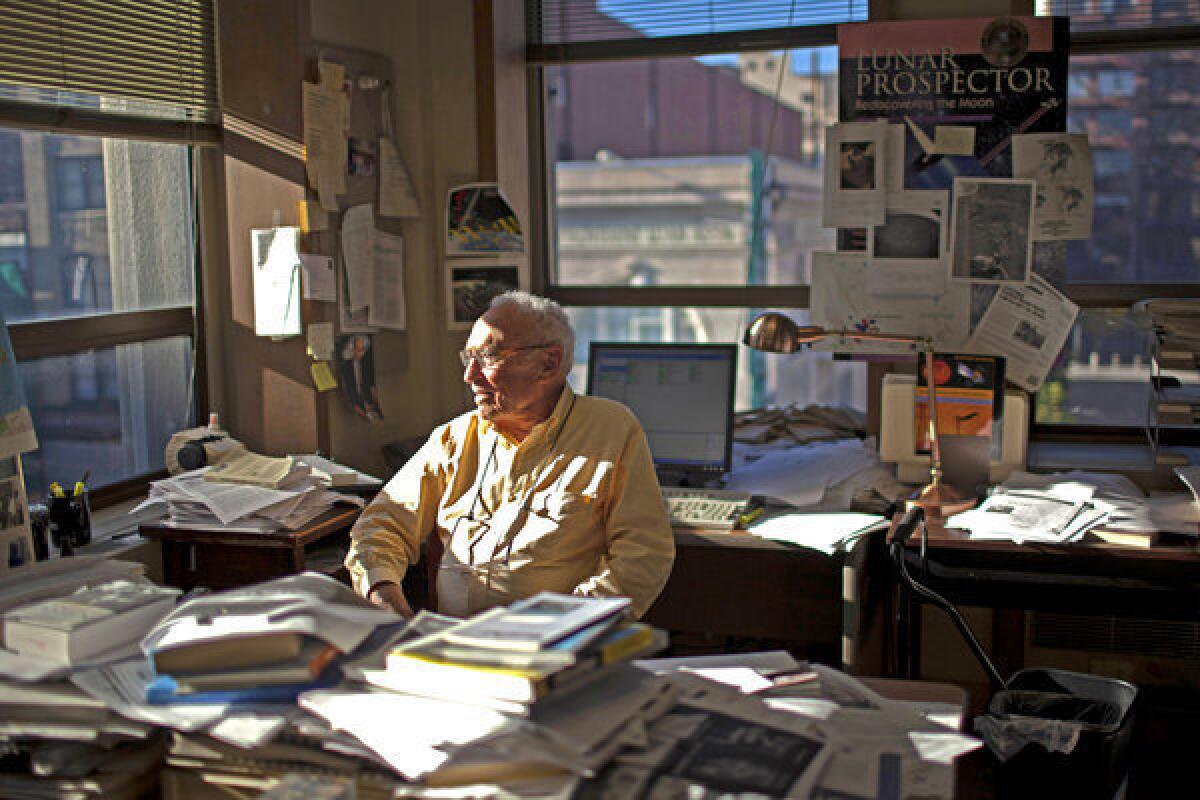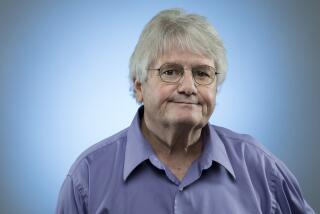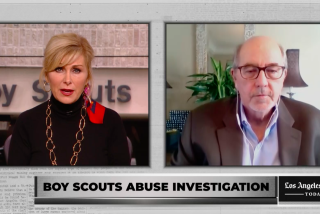Science writer is quite the specimen himself: He’s 94

SAN FRANCISCO — David Perlman had two deadlines on his mind as he elbowed his way through the Exploratorium, cane in one hand, notebook in the other.
As the San Francisco Chronicle’s veteran science writer, Perlman has been covering the granddaddy of hands-on science museums since it was just a glimmer of an idea in the fertile mind of physicist Frank Oppenheimer, the “uncle of the atom bomb.”
Now, after 43 years in the elegant but drafty Palace of Fine Arts, the museum was getting ready to close before moving to new digs on the Embarcadero, and it was Perlman’s job to chronicle the last day in its original home.
So the first deadline was his own — 6 p.m. to make the next day’s paper with a front-page story. The second belonged to the woman tagging along behind him.
She’s “doing a story about the oldest living reporter — me,” Perlman told the amused museum staff. “She has to be done before I die.”
Science and journalism have come a long way since Perlman picked up a fountain pen and began to write.
He was born in 1918, a decade before the discovery of penicillin. Pluto had yet to be discovered, let alone demoted. The ballpoint pen was invented the year he got his first real newspaper gig, a 1938 summer job covering cops in upstate New York.
Perlman can’t remember the name of the now-defunct publication, but he sure can recall his first story, a jailhouse interview with a prostitute that began something like this: Pretty Kitty Kelly sobbed in her cell at Schenectady County Jail last night.
“It was atrocious, but it was the kind of thing you did,” said Perlman, who learned his craft in the glory days of the New York tabloids. “That kind of journalism no longer exists.”
Some might quibble with Perlman’s premise (think coverage of Lindsay Lohan, Casey Anthony, Kim Kardashian), but one thing cannot be denied: It is the rare journalist who has cranked out stories as long and as skillfully as the dapper dean of science writers.
Perlman turned 94 in December, closing out a year in which he wrote 111 stories. Although only 0.2% of America’s full-time workers are 80 or older, he has no plans to slow down.
He has shrunk a bit in recent years, but the cane is more for his three children’s peace of mind than his own safety or mobility. He’s about to turn in his outdated flip phone for a newer, smarter model. A Twitter lesson is in the offing. His driver’s license is up to date.
After all, he said over a burger at a South of Market dive near Chronicle headquarters, “I’m doing exactly what I wanted to do all my life, be a reporter.”
Perlman credits his mother for a journalism career that has spanned nearly eight decades and included stints at the Bismarck Capital and the European edition of the New York Herald Tribune and 63 years at the Chronicle.
Sara Perlman took her son to see “The Front Page” — probably the Broadway version, which premiered in 1928, but possibly the 1931 movie. Perlman the nonagenarian can’t remember which; Perlman the boy was smitten either way.
The motley crew of Chicago reporters portrayed in the comedy were waiting to view a public hanging. Perlman remembers them as “seedy, catatonic Paul Reveres, full of strange oaths and a touch of childhood. I thought, ‘What a romantic characterization.’ I wanted to be that.”
Shortly thereafter, he started his first newspaper. At summer camp.
He now bears the title of “Chronicle science editor.” Prizes for science and medical writing named in his honor are awarded each year. But writing about the physical world did not come naturally to the Columbia University graduate.
After six years covering everything from a shoe store opening to the obscenity trial over Allen Ginsberg’s “Howl,” Perlman broke his leg skiing at Squaw Valley in 1957, an injury that laid him up for months. A good friend gave him a copy of “The Nature of the Universe” by British cosmologist Fred Hoyle.
A detective story would have been more welcome, Perlman recalled thinking, but by the time he had finished the pioneering science tome and was back on his feet, he was itching to find out what astronomers did all night. So he headed up to Mt. Hamilton just east of San Jose, home to the University of California’s Lick Observatory and workplace of astronomer George Herbig.
“I said, ‘What do you do for a living?’” Perlman recounted. “And he said, ‘I’m interested in stars that are being born in the Orion nebula.’ I’ve never forgotten that.... Stars getting born? It was kind of an epiphany.”
In the 56 years that have followed, Perlman has written about the changing fields of astronomy, anthropology, archaeology and alternative energy. He’s done stories on microbes, meteors, mammoths, mad cow disease, the Milky Way, the missing link.
He has covered disasters natural and man-made (earthquakes, tsunamis, oil spills) and spacecraft of all shapes and sizes (Voyager I and 2, Mariner 9, Galileo, Viking 1 and 2, Pathfinder, Sojourner, Messenger, Phoenix, rovers, Kepler, Hubble).
There was no such thing as Acquired Immune Deficiency Syndrome when Perlman began covering science and medicine; he would go on to write more than 300 stories about the disease that broke his adopted city’s heart.
Somewhere in his messy cubicle at Fifth Street and Mission he keeps a copy of his first AIDS story — among the earliest published, penned before the disease even had a name.
On June 5, 1981, the Centers for Disease Control ran an item about an outbreak of a mysterious lung ailment.
“In the period October 1980-May 1981, 5 young men, all active homosexuals, were treated for biopsy-confirmed Pneumocystis carinii pneumonia at 3 different hospitals in Los Angeles, California,” the CDC’s Morbidity and Mortality Weekly Report began. “Two of the patients died.”
Perlman was a regular reader of the report. When he saw the piece, he immediately called Dr. Selma Dritz, assistant director of the communicable disease bureau at the San Francisco health department.
“Hey, is this happening here?” he asked. “Oh, yeah,” Dritz said. “We’ve had maybe five cases too, which have not yet been reported to the MMWR.”
The short article Perlman wrote was buried deep inside the June 6 paper: “A mysterious outbreak of a sometimes fatal pneumonia among gay men has occurred in San Francisco and several other major cities, it was revealed yesterday.”
He didn’t bother to put his byline on it. At the time, he said, the cases were “just a curiosity.”
Twenty years later, his anniversary story about the “worst pandemic in modern history” cataloged the damage — “nearly 22 million people are now dead worldwide, and the count grows higher every day; more than 36 million humans are infected with the deadly virus but still alive.”
In 2008, Perlman wrote Dritz’s obituary.
Perlman has outlived colleagues he has written with, scientists he has written about, Anne, his wife of 61 years, who died in 2002. He is dating again. (In fact, at a recent wedding, he caught the bouquet.)
“I’m so lucky still to be able to do something, to do what I do.... I’m still pretty OK,” he said. “Anyway, as long as they’ll have me [at the Chronicle], I’ll stick around.”
Dr. J. Michael Bishop, chancellor emeritus at UC San Francisco and a winner of the 1989 Nobel Prize in physiology or medicine, describes Perlman as “an iconic figure in American science writing.” His curiosity is “insatiable,” his energy “even at 94 is remarkable.” Perlman, he said, “knows how to get to the essence of the science problem and explain that in terms that are clear to the general public.”
Perlman’s favorite kind of story is equal parts physical adventure, scientific discovery and opportunity to watch brilliant researchers at work.
He embarked on one such journalistic jaunt in 1977, the only reporter on board when the Galapagos Hydrothermal Expedition discovered deep-sea geysers 8,250 feet below the ocean’s surface, 400 miles west of Ecuador.
Scientists on the research vessels Knorr and Lulu were pretty sure the vents would be surrounded by a barren, underwater desert. Instead, they found a wild habitat teeming with crabs, mussels and tall, white-stalked tube worms with bright red tops.
Perlman wrote his stories on a portable Olivetti typewriter. Using a Xerox telecopier scanner, the Knorr’s radio operator sent the exclusive dispatches using a single-sideband radio to the Woods Hole Oceanographic Institution. Staffers there forwarded them to the Chronicle via Western Union.
“They have pinpointed geysers of hot water venting from fissures in fresh lava and sending warm plumes of brine shimmering upward into the near-freezing lower levels of the sea,” Perlman wrote in a March 9, 1977, story whose headline boasted “Astounding Undersea Discoveries.”
Woods Hole would later call it a “scientific discovery that changed the world.”
On a much more recent adventure, Perlman camped in the Ethiopian desert with a team of fossil-hunting paleoanthropologists who would go on to discover and assemble the partial skeleton of a pre-human creature known as Ardipithecus ramidus — a.k.a. “Ardi” — who lived 4.4 million years ago.
The researchers were working in the Afar desert, the birthplace of humankind, a two-day drive from Addis Ababa. Daytime temperatures soared to triple digits. At night, tents were zipped against scorpions and venomous snakes.
The team was protected by guards toting AK-47s, Perlman wrote, “against whom or what was never clear — but huge lion paw prints spotted at one lunch site were clear hints of danger.”
He was 88.
More to Read
Start your day right
Sign up for Essential California for news, features and recommendations from the L.A. Times and beyond in your inbox six days a week.
You may occasionally receive promotional content from the Los Angeles Times.







